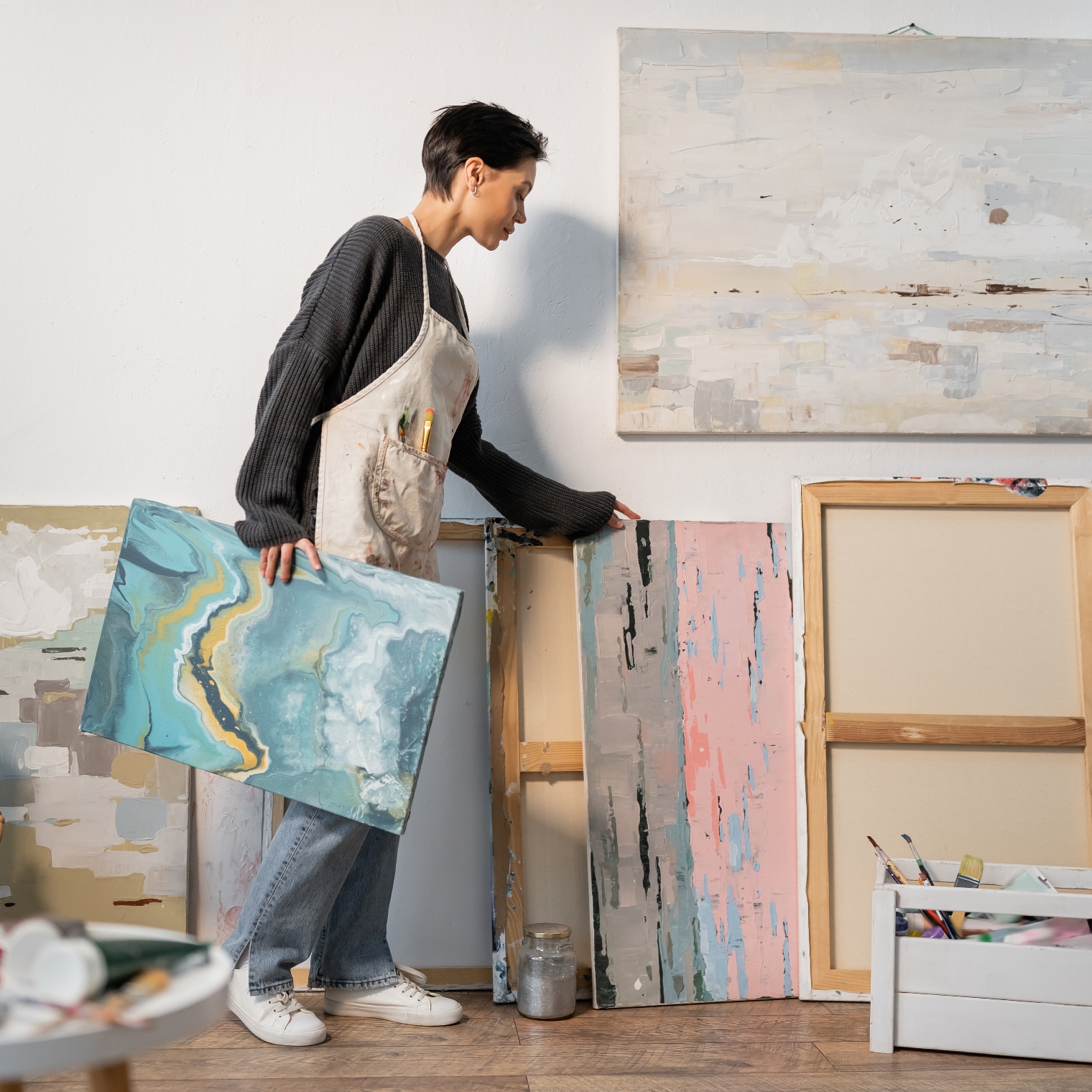Moving valuable works of art can be challenging, but with the right approach, you can safely pack your paintings and ensure they arrive intact. Whether it’s a favorite family portrait or a valuable canvas, these steps will help protect it from scratches, cracks, or tears during the move. This guide covers everything from collecting supplies to loading your painting on moving day.
Materials You’ll Need
- Sturdy cardboard box – Ideally, a flat box slightly larger than the painting. For large paintings, tape two boxes together or use a drawer-style box.
- Wrapping paper or pergamine (acid-free) – Protects the painted surface from scratches and moisture.
- Bubble wrap – Use large bubbles for better padding.
- Plastic film (stretch wrap) – Protects from dust and moisture.
- Masking tape – For securing glass and wrapping (won’t damage surfaces).
- Protective corners – Foam or cardboard, or add extra bubble wrap if needed.
- Packing tape – To seal the box securely.
- Marker – To label the box with “Fragile” and “This Side Up.”
- (Optional) Gloves – Use gloves, especially for unframed pieces, to avoid leaving smudges or fingerprints.
Step 1: Prepare the Painting
Glass-framed paintings: Remove the painting and lay it flat. Tape an “X” across the glass using masking tape, corner to corner. This helps hold the glass in place if it breaks. Remove any loose frame parts (wires, hooks) and pack them separately to avoid scratches.
Unframed canvases: Confirm the paint is fully dry. Cover the painted surface with parchment or acid-free paper. Avoid newspaper — the ink can transfer. Cover the back with paper too. If the painting is especially valuable or the paint hasn’t cured fully, wrap the whole piece in clean art plastic after the paper layer. Avoid pressing regular plastic directly onto the paint.
Step 2: Wrap with Padding
First layer: Wrap the artwork in several sheets of plain paper. For unframed pieces, place them between two slightly larger sheets of thick cardboard, like a folder protecting both sides. Tape the cardboard or paper so it doesn’t slide.
Add bubble wrap: Wrap the piece with bubble wrap, first with the bubbles facing inward, then again with bubbles out. This ensures proper cushioning on all sides.
Protect the corners: Advice from WellKnown Moving Company: Use foam corners or extra bubble wrap. Make sure all edges are covered.
Secure the wrapping: Use stretch wrap or packing tape to hold the bubble wrap in place, but don’t tape directly onto the art or frame. Wrap tightly enough that nothing shifts or rattles when shaken gently.
Step 3: Box It Up
Use a box with 2–3 inches of space around your wrapped artwork. Flat mirror/picture boxes are ideal. Avoid weak or reused boxes.
Prepare the box: Tape the bottom securely. Add 2+ inches of cushioning — crumpled paper or bubble wrap.
Insert the painting upright (on its longest edge), never flat. It should fit snugly without force. If it sticks, the box is too small or needs to be partially opened to fit.
Fill the gaps: Once the piece is in the box, fill all remaining spaces — sides, top, corners — with padding. Crumpled paper, foam, or bubble wrap all work. It should not move when shaken gently.
Packing multiple smaller artworks: Wrap each piece separately and place them upright, like books on a shelf. Separate them with cardboard or padding. Fill all voids so they can’t shift or collide.
Step 4: Seal and Label
Close the box flaps. Seal with packing tape in an “H” pattern across the top and bottom. Reinforce the edges and corners.
Label the box clearly on at least two sides:
- “FRAGILE – ART/PAINTING”
- If applicable, “GLASS – THIS SIDE UP”
Write directly on the cardboard — don’t stick labels over tape (they can fall off). Add pre-printed "Fragile" stickers if you want extra visibility.
Step 5: Transport Carefully
Keep it upright: Always stand the boxed painting on its long edge. Never lay it flat, which risks crushing or flexing.
Secure it in the truck: Wedge the box between sturdy items — a mattress, sofa, or dresser. This keeps it upright and prevents tipping. If that’s not possible, stand it upright on the floor and brace it with heavy items on either side. Don’t stack anything on top or let it lean too far.
Avoid heat and moisture: Paintings (especially oil) don’t do well with extreme conditions. Don’t leave artwork in a hot truck for hours. For long-distance moves, ventilate the truck. Once you arrive, unpack the piece soon to avoid condensation from temperature shifts.
Handling on arrival: Carry the box upright, supporting it from the bottom and side. Set it down gently and out of the way until you’re ready to unwrap and hang it.
Extra Tips
- Plan ahead: Start collecting supplies early so you're not scrambling at the last minute.
- Use gloves: Cotton or disposable gloves help keep oil, moisture, and fingerprints off artwork. If you don’t have gloves, use a clean cloth or wash your hands thoroughly before touching the art.
- Only pack dry paintings: Especially oil paintings — make sure they’re fully cured. Soft or uncured paint is at serious risk during transit.
- No printed paper: Avoid newsprint or anything with ink that could transfer.
- Hire pros for high-value art: Professional movers can custom-crate large or valuable pieces and offer climate control and insurance. Even if you move it yourself, consider taking photos for documentation and getting transit insurance.
